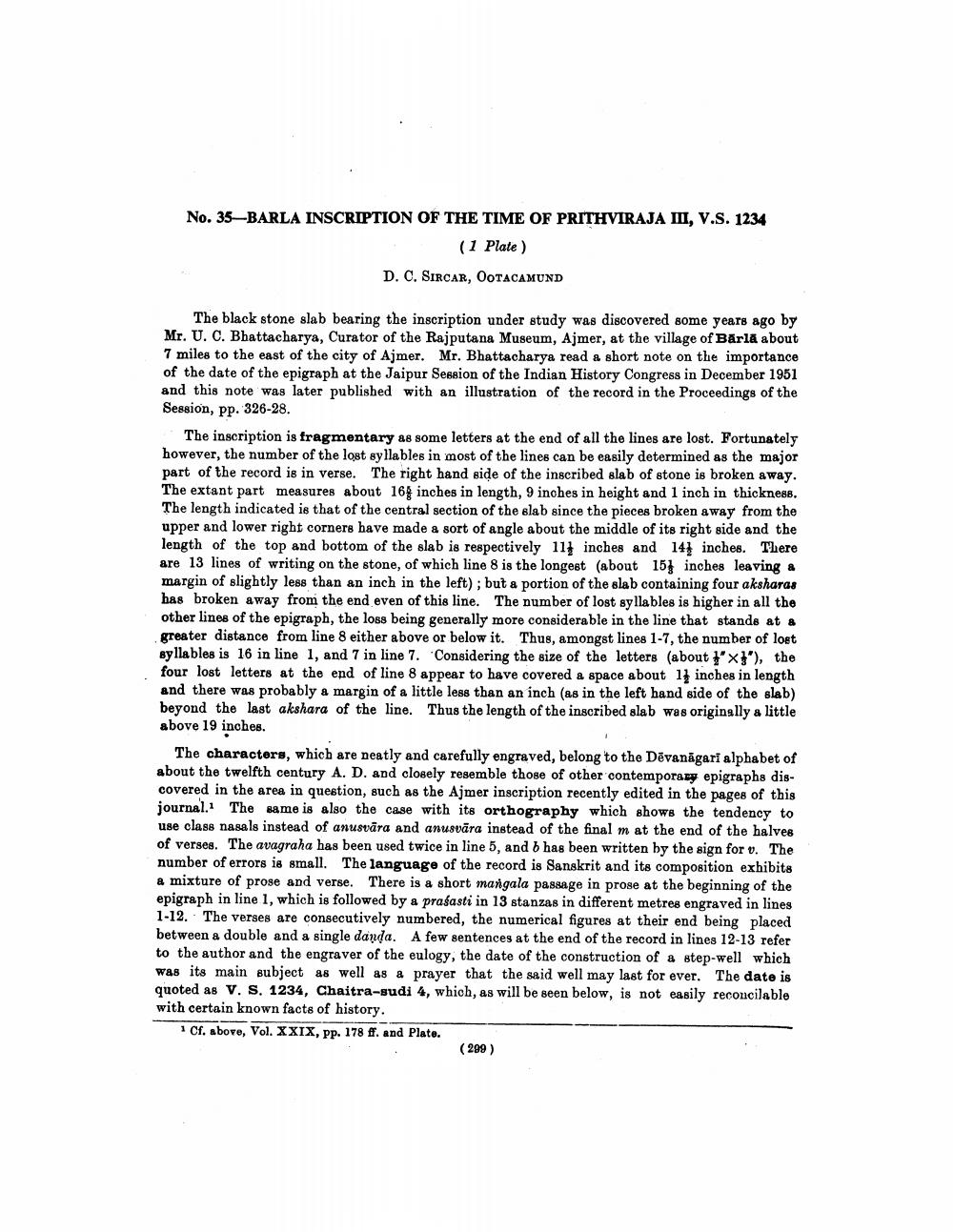________________
No. 35–BARLA INSCRIPTION OF THE TIME OF PRITHVIRAJA MI, V.S. 1234
(1 Plate)
D. C. SIRCAR, OOTACAMUND
The black stone slab bearing the inscription under study was discovered some years ago by Mr. U. C. Bhattacharya, Curator of the Rajputana Museum, Ajmer, at the village of Bārlā about 7 miles to the east of the city of Ajmer. Mr. Bhattacharya read a short note on the importance of the date of the epigraph at the Jaipur Session of the Indian History Congress in December 1951 and this note was later published with an illustration of the record in the Proceedings of the Session, pp. 326-28.
The inscription is fragmentary as some letters at the end of all the lines are lost. Fortunately however, the number of the lost syllables in most of the lines can be easily determined as the major part of the record is in verse. The right hand side of the inscribed slab of stone is broken away. The extant part measures about 164 inches in length, 9 inches in height and 1 inch in thickness. The length indicated is that of the central section of the elab since the pieces broken away from the upper and lower right corners have made a sort of angle about the middle of its right side and the length of the top and bottom of the slab is respectively 114 inches and 147 inches. There are 13 lines of writing on the stone, of which line 8 is the longest (about 153 inches leaving & margin of slightly less than an inch in the left); but a portion of the slab containing four aksharas has broken away from the end even of this line. The number of lost syllables is higher in all the other lines of the epigraph, the loss being generally more considerable in the line that stands at a greater distance from line 8 either above or below it. Thus, amongst lines 1-7, the number of loet syllables is 16 in line 1, and 7 in line 7. Considering the size of the letters (about 1'x}'), the four lost letters at the end of line 8 appear to have covered a space about 11 inches in length and there was probably a margin of a little less than an inch (as in the left hand side of the slab) beyond the last akshara of the line. Thus the length of the inscribed slab was originally a little above 19 inches.
The characters, which are neatly and carefully engraved, belong to the Dāvanāgari alphabet of about the twelfth century A. D. and closely resemble those of other contemporary epigraphs discovered in the area in question, such as the Ajmer inscription recently edited in the pages of this journal. The same is also the case with its orthography which shows the tendency to use class nasals instead of anusvāra and anusvāra instead of the final m at the end of the halves of verses. The avagraha has been used twice in line 5, and 6 has been written by the sign for v. The number of errors is small. The language of the record is Sanskrit and its composition exhibits a mixture of prose and verse. There is a short mangala passage in prose at the beginning of the epigraph in line 1, which is followed by a prasasti in 13 stanzas in different metres engraved in lines 1-12. The verses are consecutively numbered, the numerical figures at their end being placed between a double and a single danda. A few sentences at the end of the record in lines 12-13 refer to the author and the engraver of the eulogy, the date of the construction of a step-well which was its main subject as well as a prayer that the said well may last for ever. The date is quoted as V. S. 1234, Chaitra-sudi 4, which, as will be seen below, is not easily reconcilable with certain known facts of history. 1 Cf. above, Vol. XXIX, pp. 178 ff. and Plate.
(299)




